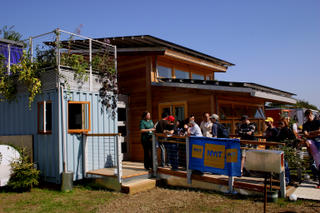I have always equated solar homes to regular homes with solar panels on the roof. Not any more!. Little did I know about phase change materials and its use to store energy. Solar thermal collectors that directly heat water and the space inside the house.
Little did I know of passive solar energy and the importance of daylighting to save energy. Low emissivity windows. Energy Recovery Ventilators (ERVs) that use heat exchangers to transfer heat from outgoing air to the incoming air.
Simply stated...Architecture, design, simplicity, efficiency and technology all play an important role.
The 18 teams were judged on all those categories. University of Colorado's solar home was declared the overall winner. Cornell University and California Polytechnic State University stood second and third respectively
 University of Colorado's key focus was modularity to promote mass production and use of natural materials to promote true sustainable construction. The materials used range from soy, corn, sunflower, canola and coconut. They are awaiting a patent on their remarkable biobased (soy) Structural Insulated Panel (SIP). They call it the BIOSIP.
University of Colorado's key focus was modularity to promote mass production and use of natural materials to promote true sustainable construction. The materials used range from soy, corn, sunflower, canola and coconut. They are awaiting a patent on their remarkable biobased (soy) Structural Insulated Panel (SIP). They call it the BIOSIP.The Cornell University's called its home the smart home with all its systems controlled automatically.

I found its grey water recycling system quite interesting. All of the water from the shower and bathroom drains are sent to a greywater filtration wall consisting of plants, gravel, and rocks. Filtration and landscaping cleverly put together.
Cornell students were most excited about their silicon gel based Energy Recovery Ventilator (ERV). It considerably reduces the energy required to cool and heat the house. Finally a noble use for silicon gel :)
In sharp contrast to Cornell, California Polytechnic relied less on automation. Their mantra was simplicity.
 Very few gadgets and controls. The design was more geared towards the warmer climate of California. It is designed to optimize solar gain in winter and minimize heat gains in summer. It gives the residents of the house almost complete control.
Very few gadgets and controls. The design was more geared towards the warmer climate of California. It is designed to optimize solar gain in winter and minimize heat gains in summer. It gives the residents of the house almost complete control.For the example the shade panels (as seen in the photograph) can be moved forward or backward depending on the season to let more or less sun in.
The common thread to all the 18 homes was a local climate centric design. The Canadians designed their home to withstand extreme cold winters. The Spanish design was in tune with the Mediterranean lifestyle. The team from Puerto Rico payed attention to their island life and locally available and renewable material.
While all designs were good, I felt one in particular was exceptional and did not get its due credit. New York Institute of Technology (NYIT) was the only team to incorporate Hydrogen Fuel Cells into the mix. Electricity from a roof-mounted Photo Voltaic (PV) system is used to separate water into hydrogen and oxygen through electrolysis; the hydrogen is collected and stored and later used to power a fuel cell. The fuel cell recombines hydrogen with oxygen to supply electricity. This system replaces all those acid filled "not so environmental friendly" batteries.

The best part of the walk-through was when a volunteer from the NYIT team said this,
"Hydrogen is the most abundant thing on our planet. We wouldn't have to go to Iraq to get it".
There was immediate applause and cheer from the crowd.
Every team emphasized the fact the technology and the concepts used in their projects are not futuristic. GE makes them, BP Solar makes them and Home Depot supplies them. The technology is available today.
One has to applaud these students for their effort. They plan to take these projects back to their college and their communities to spread awareness, increase adoption and in some cases help draft new legislation. Hats off !. It is such a shame that the media coverage of this event was almost absent. These students deserve better.
The US department of Energy website has a wealth of information at http://www.eere.energy.gov/solar_decathlon
"What is the use of a house if you haven't got a tolerable planet to put it on?"
~ Henry David Thoreau
PS:
All the houses had arrays of roof mounted PV panels. Everyone except NYIT had arrays of batteries also to store electricity

3 comments:
WOW! Thank you for such great information! I didn’t see any news reports about this at all. Like you said, I was assuming “solar homes” were just regular homes with solar panels. Wow. It’s amazing that all of this technology, and materials, are available to us right now and we aren’t using them. What will it take for architects and construction companies to start implementing these projects?
I would have loved to be at one of these exhibitions........some day i'll build a house, with lots of these features..
Patrix, Thanks for linking. Yes, it was a great experience.
Jennifer, You ask a good question. I need to find out more before I can answer your question
Sunil, Somebody me too
Post a Comment